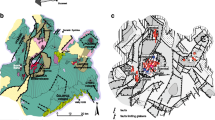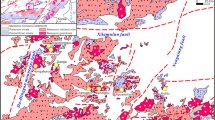Abstract
The Tamir molybdenum occurrence is one of the promising objects of the Selenginsky ore region of Western Transbaikalia. Ore occurrence is a zone of quartz–molybdenite (with beryl) veins and veinlets in leucogranites and granite–porphyries. Thermobarogeochemical methods for studying individual fluid inclusions in quartz and beryl provided the first data on the formation conditions and salt composition of the ore-forming fluids that formed the quartz–molybdenite ores of the Tamir ore occurrence. It was determined that the ores of the Tamir occurrence were formed from relatively weakly saline (~3.4–11.2 wt % NaCl equiv.) CO2-containing solutions, with a decrease in temperature in the range from 336 to 215°C, with the main salt components of ore-forming solutions being Ca, Na and K chlorides.




Similar content being viewed by others
Notes
Here and below, the letter “f” denotes unpublished stock materials and production reports.
REFERENCES
Baturina, E.E. and Ripp, G.S., Molibdenovye i vol’framovye mestorozhdeniya Zapadnogo Zabaikal’ya (osnovnye cherty metallogenii i geokhimii) (Molybdenum and Tungsten Deposits of Western Transbaikalia: Main Features of Metallogeny and Geochemistry), Moscow: Nauka, 1984.
Bodnar, R.J. and Vityk, M.O., Interpretation of microthermometric data for H 2 O–NaCl fluid inclusions, Fluid Inclusions in Minerals: Methods and Applications, Blacksburg: Verginia Tech, 1994, pp. 117–130.
Borisenko, A.S., Cryometric study of salt composition of gas–liquid inclusions in minerals, Geol. Geofiz., 1977, no. 8, pp. 16–27.
Damdinova, L.B., Damdinov, B.B., Huang, X.-W., Bryansky, N.V., Khubanov, V.B., and Yudin, D.S., Age, conditions of formation, and fluid composition of the Pervomaiskoe molybdenum deposit (Dzhidinskoe ore field, south-western Transbaikalia, Russia), Minerals, 2019, vol. 9, no. 10, p. 572. https://doi.org/10.3390/min9100572
Gordienko I.V., Badmatsyrenova R.A., Lantseva V.S., and Elbaev A.L. Selenga ore district in Western Transbaikalia: structural–minerogenic zoning, genetic types of ore deposits, and geodynamic settings of ore localization, Geol. Ore Deposits, 2019, vol. 61, no. 5, pp. 391–421.
Roedder, E., Fluid Inclusions, Rev. Mineral., 1984, vol. 12.
Funding
This research was carried out with the financial support of the Russian Foundation for Basic Research (grant no. 18-45-030002 r_a 2018) and within the framework of a state order to the Dobretsova Geological Institute, Siberian Branch, Russian Academy of Sciences (DGIN SB RAS) (projects of the DGIN SB RAS state reg. AAAA-A21-121011390003-9, No. AAA-A21-121011890029-4). The work was carried out using the equipment of the Center for Collective Use “Geospektr” of the DGIN SB RAS (Ulan-Ude).
Author information
Authors and Affiliations
Corresponding authors
Ethics declarations
The authors declare that they have no conflict of interest.
Rights and permissions
About this article
Cite this article
Damdinova, L.B., Elbaev, A.L. The Tamir Molybdenum Event (Western Transbaikal, Russia): the First Data on the Physicochemical Formation Parameters. Geol. Ore Deposits 64, 389–394 (2022). https://doi.org/10.1134/S1075701522060034
Received:
Revised:
Accepted:
Published:
Issue Date:
DOI: https://doi.org/10.1134/S1075701522060034




